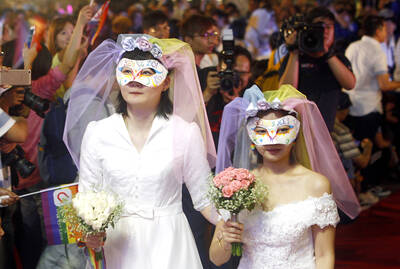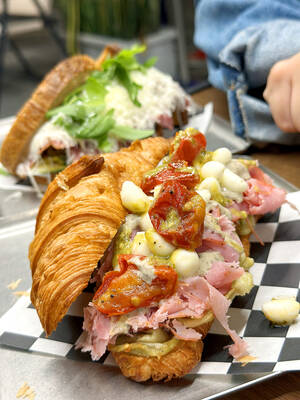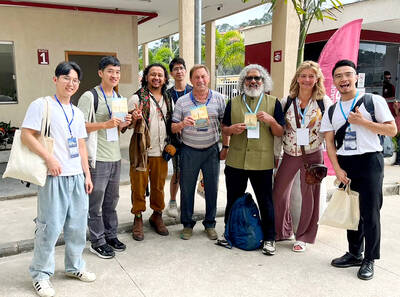Modern Chinese history, Yu Peter Kien-hong argues, can be divided into two defining periods — the First Long March, led by Communist leader Mao Zedong (毛澤東) to “liberate peasants and farmers,” and the Second Long March, in which non- and anti-communists sought to “promote full-fledged and mature constitutional democracy” in China.
Yu, a professor at Ming Chuan University, posits that Taiwan and “mainland China” are both part of the Republic of China (ROC). Both Taiwan and the People’s Republic of China (PRC), though they have engaged in different, lesser marches since, are bound by the same destiny, in the form of the ROC Constitution, to “reunite” at one point. As the ROC was never dissolved, the PRC is a derivative of, or partial successor to, the ROC. In other words, it did not completely replace the ROC, meaning that it can only claim sovereignty over Taiwan as part of the ROC.
To make his point, Yu walks us through the marches led by Chiang Kai-shek (蔣介石), Yan Chia-kan (嚴家淦), Chiang Ching-kuo (蔣經國), Lee Teng-hui (李登輝) and Chen Shui-bian (陳水扁), arguing that despite great contests of power and changing times, the leadership in Taiwan — which throughout the book the author annoyingly refers to as “Taiwan area” — nevertheless continued to adhere to the ROC Constitution, which in his view has worked quite well in its “struggle” against the CCP.
While not shying away from criticizing the Chiangs and Lee, Yu shows his true political colors in his description of Chen, whose election engendered a “political mess plus scandals of one type or another,” and who did a “terrible job” as president. Yu’s problem, however, is that in the 35 pages he dedicates to the Chen march, he fails to show us why his tenure was so terrible, relying on the 2004 shooting incident — a favorite of deep blues in their attacks on the former president — to somehow make his point. Here, as in many books written by KMT sympathizers, the pan-blue camp’s scorched earth tactics in the legislature, which often prevented the executive from governing, are papered over.
It is more likely, therefore, that Yu’s unfavorable characterization of Chen lies in the fact that the latter was the leader who came closest to abandoning the
so-called Second March by forsaking the ROC Constitution in his efforts to create a Republic of Taiwan (ROT). Doing so would have destroyed, once and for all, the theory — now on life support — that “mainland China” and Taiwan are two parts of the ROC.
As long as Taiwan adheres to the Constitution, written under much different times in 1947, it is possible to hope, as Yu does, that at some point in future it will be possible for the two sides to “reunite.” As this is ostensibly Yu’s preferred scenario, Chen’s pro-Taiwan ideology was therefore a threat. This prompts him into reminding us, though he is wrong, as it turns out, that Ma Ying-jeou’s (馬英九) victory in 2008 was a “severe warning” sent by the “majority” of voters in the pan-blue camp “that the ROC [i.e., Taiwan] cannot abandon mainland sovereignty.” We all know, of course, that the majority of people who voted for Ma did so because he promised to revive the economy and improve relations with Beijing, not because of some deep-felt desire to claim sovereignty over China.
For all his opposition to Chen’s efforts to create a Republic of Taiwan — which like the PRC could arguably be seen as a “successor” of the ROC — Yu fails to mention that in 1954 Beijing adopted its own Constitution of the People’s Republic of China, which rather than draw from the ROC Constitution, is modeled after the Constitution of the Soviet Union, written in 1936. We can therefore argue that the disconnect that obviated the ROC Constitution was not caused by the Taiwanese independence movement, but rather by the enactment of the PRC Constitution, the latest version of which was adopted in 1982. Yu would be extremely naive if he thought that “reunification” would occur under terms other than the PRC’s — that is, under the ROC framework he advocates.
Equally unpersuasive is Yu’s argument that the KMT should join forces with like-minded elements in China in fostering full democracy, efforts that surely would take us closer to war in the Taiwan Strait than anything the Lee and Chen administrations ever did in the name of Taiwanese independence. Toward the book’s end, Yu himself admits that the CCP prioritizes its hold on power and only sees the possibility of democracy “with Chinese characteristics” at some distant point in the future. He also ignores the impact that more than 110 years of separate rule has had on identity in Taiwan and people’s desire to link their destinies with a regime that, to all, is an alien one.
Sadly, the relatively simple — and by no means original — theory at the core of The Second Long March is marred by damnably poor editing and the author’s tendency to jump from one point to another without any seeming connection between them, which is distracting and often confusing. Outrageous passages, such as his claim that 650,000 natives of Taiwan — or one-tenth of the population — were slaughtered by Imperial Japanese forces during the colonial period (the figure is closer to 30,000, according to many experts, while only Chinese propaganda supports such numbers), serve to discredit Yu and raise questions about the intentions of his badly written, flawed and ultimately unconvincing his book.

This month the government ordered a one-year block of Xiaohongshu (小紅書) or Rednote, a Chinese social media platform with more than 3 million users in Taiwan. The government pointed to widespread fraud activity on the platform, along with cybersecurity failures. Officials said that they had reached out to the company and asked it to change. However, they received no response. The pro-China parties, the Chinese Nationalist Party (KMT) and Taiwan People’s Party (TPP), immediately swung into action, denouncing the ban as an attack on free speech. This “free speech” claim was then echoed by the People’s Republic of China (PRC),

Exceptions to the rule are sometimes revealing. For a brief few years, there was an emerging ideological split between the Democratic Progressive Party (DPP) and Chinese Nationalist Party (KMT) that appeared to be pushing the DPP in a direction that would be considered more liberal, and the KMT more conservative. In the previous column, “The KMT-DPP’s bureaucrat-led developmental state” (Dec. 11, page 12), we examined how Taiwan’s democratic system developed, and how both the two main parties largely accepted a similar consensus on how Taiwan should be run domestically and did not split along the left-right lines more familiar in

Specialty sandwiches loaded with the contents of an entire charcuterie board, overflowing with sauces, creams and all manner of creative add-ons, is perhaps one of the biggest global food trends of this year. From London to New York, lines form down the block for mortadella, burrata, pistachio and more stuffed between slices of fresh sourdough, rye or focaccia. To try the trend in Taipei, Munchies Mafia is for sure the spot — could this be the best sandwich in town? Carlos from Spain and Sergio from Mexico opened this spot just seven months ago. The two met working in the

Many people in Taiwan first learned about universal basic income (UBI) — the idea that the government should provide regular, no-strings-attached payments to each citizen — in 2019. While seeking the Democratic nomination for the 2020 US presidential election, Andrew Yang, a politician of Taiwanese descent, said that, if elected, he’d institute a UBI of US$1,000 per month to “get the economic boot off of people’s throats, allowing them to lift their heads up, breathe, and get excited for the future.” His campaign petered out, but the concept of UBI hasn’t gone away. Throughout the industrialized world, there are fears that